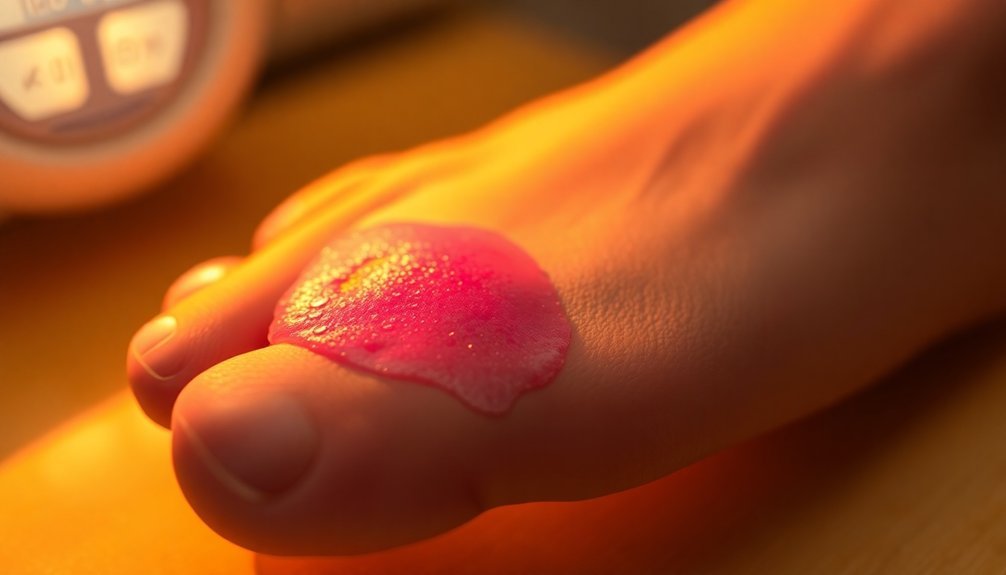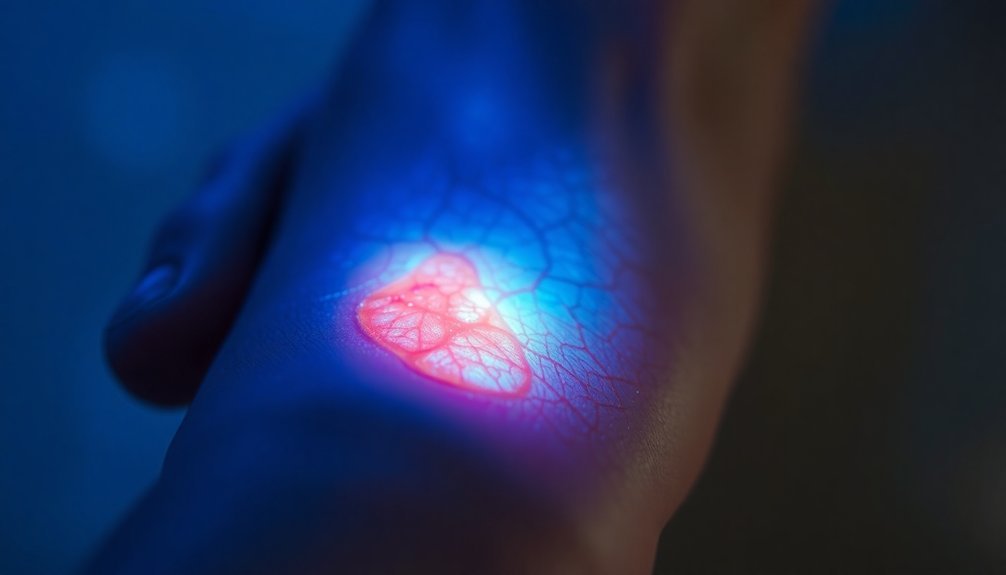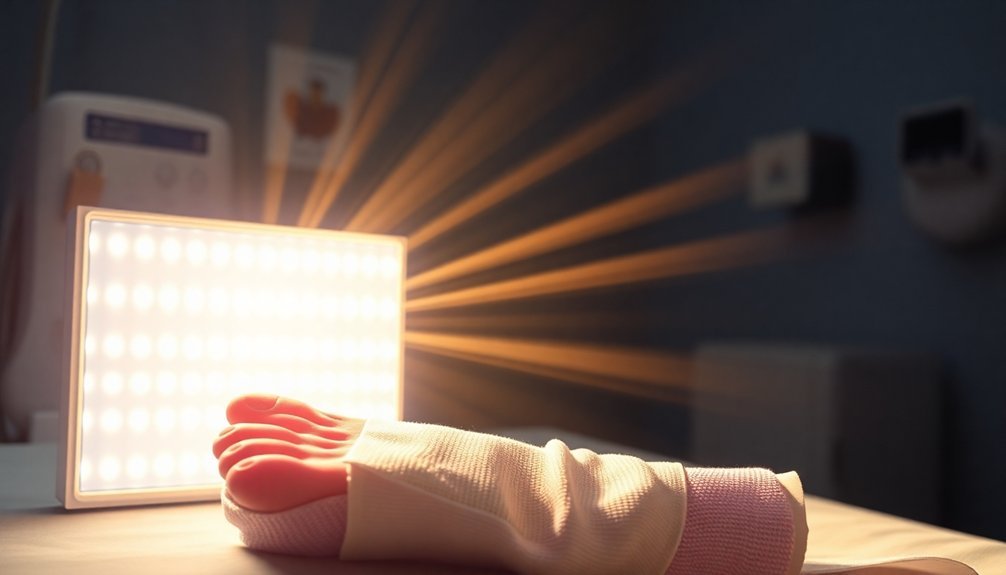Photobiomodulation (PBM) can make your diabetic wounds disappear faster by boosting cellular energy production and reducing inflammation. It activates mitochondria to generate more ATP, which fuels essential healing processes. PBM also lowers pro-inflammatory cytokines, improving cellular function and promoting fibroblast activity—key players in wound healing. Specific wavelengths of light improve cell proliferation and migration, leading to quicker wound closure. Additionally, PBM enhances blood flow and reduces oxidative stress, creating a more favorable healing environment. It's fascinating how this technology works; stick around to uncover even more benefits and details about PBM and its impact on wound healing.
Mechanism of Action

Photobiomodulation (PBM) works wonders by stimulating your cells, particularly the mitochondria, to enhance energy production. This stimulation boosts the production of ATP, which is fundamental for your cellular energy and function.
PBM interacts with the mitochondrial cytochrome c oxidase, activating this important protein in the electron transport chain and improving overall cellular metabolism. The effectiveness of this process hinges on specific wavelengths, with near-infrared and red light proving to be the most beneficial.
Beyond energy production, PBM modulates various cellular signaling pathways that are essential for wound healing. It encourages fibroblast cell proliferation and migration, inducing the release of critical growth factors like Fibroblast Growth Factor (FGF) and Platelet-Derived Growth Factor (PDGF). Studies have demonstrated that PBMT enhances healing processes, significantly decreasing chronic inflammation in diabetic wounds.
These factors initiate a cascade of events that enhance tissue repair and regeneration. Furthermore, PBM increases fibroblast functionality, helping these cells secrete collagen and build the extracellular matrix, thereby facilitating wound healing.
The therapy promotes fibroblast transformation into myofibroblasts, necessary for effective tissue remodeling. Essentially, PBM operates through intricate cellular mechanisms to greatly speed up the healing of diabetic wounds.
Reducing Inflammation and Stress
When you apply photobiomodulation (PBM) to diabetic wounds, you considerably reduce pro-inflammatory cytokines like TNF-α and IL-1β. This reduction leads to lower oxidative stress levels, creating a healthier environment for healing. By decreasing oxidative stress, PBM enhances cellular viability, proliferation, and migration in fibroblast cells, further promoting the healing process.
Cytokine Modulation Effects
A key benefit of using photobiomodulation (PBM) is its ability to modulate cytokine activity, effectively reducing inflammation and stress in diabetic wounds. By decreasing pro-inflammatory cytokines like TNF-α and IL-1β, PBM helps create a less inflammatory environment, which is essential for wound healing. For example, studies reveal that irradiation at 660 nm and 810 nm remarkably lowers pro-inflammatory cytokines in diabetic models. Additionally, enhanced mitochondrial function is crucial for the cellular metabolism that supports the healing process.
Here's a summary of how PBM influences cytokine activity:
| Cytokine Type | Effect of PBM |
|---|---|
| Pro-Inflammatory | Reduces levels of TNF-α and IL-1β |
| Anti-Inflammatory | Increases release of cytokines like IL-6 |
| Growth Factors | Up-regulates bFGF for tissue repair |
| Macrophage Activity | Shifts macrophages to a pro-healing phenotype |
| Tissue Regeneration | Promotes collagen synthesis and angiogenesis |
Oxidative Stress Reduction
Recent advancements in photobiomodulation (PBM) have highlighted its effectiveness in reducing oxidative stress, which plays a pivotal role in the healing process of diabetic wounds. By enhancing mitochondrial function and increasing ATP production, PBM can appreciably decrease oxidative stress without triggering harmful oxidative stress-activated processes.
Specifically, exposure to near-infrared (NIR) light promotes a shift from anaerobic to aerobic metabolism, further reducing oxidative stress.
When you utilize wavelengths like 632.8 nm and 660 nm, you can witness a decrease in both oxidative and nitrosative stress in diabetic wounds. This treatment also moderately modulates reactive oxygen species (ROS) production, leading to increased cellular viability and proliferation in hypoxic conditions.
As the inflammation reduces, the expression of pro-inflammatory cytokines such as TNF-α and IL-1β diminishes, allowing for a more favorable healing environment.
The combined effects of oxidative stress reduction and decreased inflammation result in enhanced cellular proliferation and migration. Ultimately, PBM accelerates the healing process, leading to faster wound closure and better overall outcomes for diabetic patients.
It's a game changer in wound care management.
Enhancing Cell Proliferation

When you apply photobiomodulation (PBM) to diabetic wounds, you'll notice a significant boost in fibroblast activation.
This process triggers the release of essential growth factors, promoting enhanced cell migration necessary for effective healing.
Fibroblast Activation Boost
Through the application of photobiomodulation (PBM), fibroblast activation can be greatly boosted, leading to enhanced cell proliferation in diabetic wounds. Studies show that PBM, particularly at 660 nm, markedly increases cellular viability in diabetic fibroblast cells. This increase isn't just limited to normoxic conditions; even in hypoxic environments, fibroblast viability rises, contributing to a reduction in cell apoptosis.
Moreover, the stimulation of cell migration is crucial for effective wound healing, and PBM achieves this by activating cellular pathways. For instance, irradiation at 660 nm stimulates the bFGF-activated Ras/MAPK pathway, accelerating cell migration—this is essential for closing wounds more swiftly.
Further activation of the JAK/STAT pathway and the TGF-β1/Smad signaling pathway enhances fibroblast activities, promoting both proliferation and migration. The right parameters, like a fluence of 5 J/cm² at 660 nm or 830 nm, optimize these effects, ensuring maximum fibroblast activation.
Growth Factor Release
Photobiomodulation (PBM) plays a pivotal role in enhancing the release of essential growth factors, which are fundamental for cell proliferation in diabetic wounds.
When you apply PBM at specific wavelengths, like 660 nm or 830 nm, you can considerably boost the release of growth factors such as bFGF, EGF, VEGF, PDGF, and TGF-β 1. Each of these factors has a unique role in the healing process, activating crucial pathways that promote cellular growth and repair.
For instance, bFGF, stimulated by PBM, activates the Ras/MAPK signaling pathway, which enhances both cellular proliferation and migration, essential for wound healing.
This increased release of growth factors not only improves cell viability but also accelerates overall wound closure.
You'll notice that the right choice of wavelength and fluence during treatment is fundamental for maximizing growth factor release, ultimately leading to better healing outcomes.
Enhanced Cell Migration
Boosting cell migration is essential for effective wound healing, especially in diabetic conditions where cellular activity often declines. Photobiomodulation (PBM) can be a game-changer here. By using specific wavelengths of light, such as 632.8 nm and 660 nm, PBM stimulates important cellular processes that promote tissue regeneration. This treatment activates signaling pathways that enhance cell migration, particularly in dermal fibroblast cells, which are significant for wound healing.
Here's a quick overview of how PBM enhances cell migration:
| Mechanism | Description |
|---|---|
| Mitochondrial Targeting | Stimulates cytochrome c oxidase for ATP production |
| Cytokine Reduction | Lowers pro-inflammatory cytokines (TNF-α, IL-1β) |
| Cell Type Specificity | Activates fibroblasts, macrophages, and angiogenic cells |
| Ideal Wavelengths | Red/NIR light (e.g., 633-808 nm) enhances effectiveness |
| Proven Results | Faster wound contraction in diabetic models |
With PBM, you're not just seeing improved cell migration; you're creating a healing environment that means quicker recovery and relief from the challenges of diabetic wounds.
Accelerating Wound Healing
Often, diabetic wounds present considerable challenges due to delayed healing processes and increased inflammation. Fortunately, photobiomodulation (PBM) can accelerate your wound healing by reducing inflammation and oxidative stress. It lowers pro-inflammatory cytokines like TNF-α and IL-1β, creating a more conducive environment for healing.
By inhibiting apoptosis in fibroblast cells, PBM promotes cell survival, allowing for efficient tissue repair. You'll also notice improvements in cell migration and proliferation. PBM increases cellular viability and stimulates fibroblast migration, essential for rebuilding tissue. It enhances the production of growth factors, further supporting these processes and boosting collagen organization, which is critical for wound strength.
In addition, PBM plays a role in tissue regeneration by promoting the extracellular matrix and collagen synthesis. By facilitating granulation tissue formation, PBM improves wound contraction and scar durability. It enhances angiogenesis, ensuring that your wounds receive adequate oxygen and nutrients.
Finally, PBM aids in bacterial clearance and wound closure, considerably decreasing infection risk. When combined with conventional treatments, PBM accelerates healing rates, dramatically reducing the size of diabetic foot ulcers and helping you recover faster.
Optimal Treatment Parameters

To maximize the benefits of PBM in diabetic wound healing, understanding and applying ideal treatment parameters is key. You should focus on the effective wavelengths of red (630-700 nm) and near-infrared light (700-1100 nm). Specifically, 633 nm and 660 nm have shown considerable improvements, enhancing fibroblast migration considerably.
The 808 nm wavelength is particularly beneficial for epithelialization and collagen synthesis in diabetic wounds.
When determining fluence, aim for 2.35 J/cm² for general diabetic healing, increasing up to 5 J/cm² to promote fibroblast activity. Higher fluences like 18.288 J/cm² can result in increased collagen production.
Pay attention to power density; 0.1 W/cm² is ideal for wound contraction and epithelialization. Avoid going above 0.3 W/cm², as higher levels might inhibit healing.
Lastly, you should consider treatment frequency. Administering PBM three times a week is standard, while daily treatments may accelerate healing, especially for infected wounds.
Consistency is critical; maintaining exposure times and administration schedules can considerably enhance the healing process.
Clinical Benefits of PBM
Photobiomodulation (PBM) offers a range of clinical benefits that greatly enhance the healing process for diabetic wounds. By promoting tissue regeneration and accelerating wound repair, PBM provides a powerful tool for patients struggling with slow-healing injuries. Here's a quick overview of its key benefits:
| Clinical Benefit | Details | Impact |
|---|---|---|
| Enhanced Tissue Regeneration | Boosts cellular proliferation and collagen synthesis | Speeds up wound healing |
| Reduction of Inflammation | Decreases pro-inflammatory cytokines | Creates a healthier wound environment |
| Improvement in Fibroblast Function | Enhances fibroblast activity and growth factor release | Supports effective healing |
| Enhanced Wound Closure | Accelerates closure rates and increases tissue strength | Improves overall recovery |
PBM not only reduces inflammation and pain but also improves fibroblast function. This promotes ideal wound healing by supporting the extracellular matrix's reconstruction. Enhanced blood flow and reduced microbial presence are additional perks, ensuring better outcomes compared to untreated wounds. With these benefits, PBM stands as a highly effective option for managing diabetic wounds, offering hope for faster recovery.
Future Research Directions

As researchers explore deeper into the potential of photobiomodulation (PBM) for diabetic wound healing, a multitude of future research directions beckon.
You'll likely see increased investigation into ideal wavelengths and their effects on cellular processes, focusing on fibrobasts' proliferation and migration. Understanding the complex cell signaling pathways involved is essential for enhancing PBM's efficacy.
Additionally, clinical trials are needed to validate PBM's effectiveness in various patient subgroups, evaluating long-term outcomes compared to other therapies. Monitoring adverse effects will also be important to establish safety profiles.
Technological advancements promise exciting possibilities, too. An exploration of LED technology may provide cost-effective treatment alternatives, while portable devices could improve accessibility and compliance.
You'll want to keep an eye on dosage refinement and real-time monitoring systems that'll personalize and enhance therapy.
Economically, researchers should analyze PBM's cost-effectiveness and its impact on patients' quality of life. Addressing access to PBM in underserved areas will be essential.
These future research directions will help realize PBM's full potential in revolutionizing diabetic wound care and improving patient outcomes considerably.
Frequently Asked Questions
Is PBM Therapy Painful or Uncomfortable for Patients?
PBM therapy isn't painful or uncomfortable for you. It's a non-invasive treatment that doesn't raise tissue temperature or cause discomfort, allowing you to relax without anesthesia while promoting healing effectively and comfortably.
How Long Does a Typical PBM Treatment Session Last?
A typical photobiomodulation treatment session lasts between 1 to 2 minutes. You'll usually receive treatments twice a week, but sometimes you might have six sessions in a week for faster results.
Are There Any Side Effects Associated With PBM Therapy?
You won't experience significant side effects with PBM therapy. Most reports indicate only mild, temporary issues like headaches or local pain, meaning it's a safe, non-invasive option for various treatments without major risks.
Can PBM Be Used on All Types of Wounds?
Yes, PBM can be used on various wound types, including burn wounds, chronic ulcers, and infected wounds. It enhances healing, reduces inflammation, and promotes tissue regeneration, making it a versatile option for wound care.
How Quickly Can Patients See Improvement With PBM Treatment?
You'll likely notice improvements within one to three weeks of starting PBM treatment. Many patients experience faster healing, with significant reductions in wound size and better tissue regeneration compared to untreated wounds.
In Summary
Photobiomodulation offers an innovative approach to accelerating healing in diabetic wounds by reducing inflammation, enhancing cell proliferation, and speeding up the overall wound healing process. By understanding the ideal treatment parameters, you can harness its clinical benefits effectively. As research continues to expand, the potential for PBM to revolutionize diabetic wound care becomes even clearer. Embracing this technology could transform healing outcomes and improve quality of life for those affected by diabetes-related wounds.





Leave a Reply